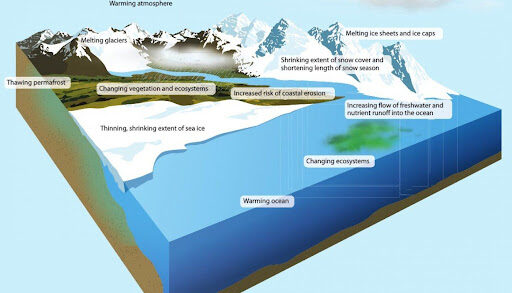Table of Contents
Artic Warming Overview
-
- Earlier studies have shown that the Arctic is warming two or three times faster, but the recent studies show that change is very fast.
- The warming event is more concentrated in the Eurasian part of the Arctic. Barents Sea north of Russia and Norway is warming seven times faster than the global average.
Artic Warming Previous Studies
- Study by Inter-governmental Panel on Climate Change says that Arctic surface air temperature has increased by more than double the global average over the last two decades.
- Arctic Monitoring and Assessment Programme (AMAP): The study says that chance of the sea ice completely melting in summers is 10 times greater, if the global temperature rises by two degrees Celsius above the pre-industrial levels.
- The average annual temperature in the region increased by 3.1 degree Celsius while it is 1 degree Celsius for the planet.
About Arctic Amplification
- The phenomenon of more intense impact of global warming across northern latitudes is known as Arctic amplification
- Any changes in the surface air temperature and the net radiation balance create larger changes at the north and south poles.
- Global warming caused due to Anthropogenic activities since pre-industrial times and has increased the planet’s average temperature by 1.1 degrees Celsius.
Causes for Arctic Amplification
- Primary causes are ice-albedo feedback, water vapour feedback, lapse rate feedback and ocean heat transport.
- Albedo effect: Ice has higher potential to reflect solar radiation, which prevents ice from melting. As ice starts melting, solar radiation is absorbed by oceans, amplifying melting.
- Lapse rate: It is the rate at which temperature drops as the elevation decreases. Lapse rate decreases with warming and hence ice formation is affected.
- Water vapour feedback: It is the coupling between water vapour and surface air temperature in which a change in the surface air temperature can lead to a change in water vapour, which could then amplify or weaken the initial temperature change.
- Ocean heat transport: The heat carried by the Atlantic and Pacific Oceans from tropics has a significant influence on the decrease in Arctic sea ice.
- The ice-albedo feedback and the lapse rate feedback are together responsible for 65% of polar amplification.
Consequences of Arctic warming
- Ice melt: Ice in polar areas, especially Greenland, is melting at an alarming rate. Summers this year witnessed melt of 6 billion tonnes of ice sheet per day.
- Sea level rise: Greenlandic ice hold second highest amount of water, which is critical for maintaining the sea level.
- If Greenlandic ice sheets completely melt, it could raise the sea level by seven metres that can drown island countries and major coastal cities.
- Biodiversity: The warmer ocean results in acidification and also salinity levels. This can impact biodiversity, including the marine species and the dependent species.
- Adverse rainfall: Warming increases the occurrence of rainfall which is affecting the availability and accessibility of lichens to the reindeer.
- Arctic fauna is facing starvation and death due to unavailability of food.
- Greenhouse gas emission: Warming is causing thawing of permafrost. This event results in releasing carbon and methane that were trapped under ice.
- Pathogen outbreak: Thawing of permafrost can also release virus, bacteria and other pathogens trapped below ice. This can result in new diseases for humans and animals.
Impacts of Artic Warming on India
- Extreme weather events: There are chances of extreme weather events due to changes in ocean temperature and pressure. There will be visible effects on water and food security.
- Extreme rainfall: Reduction of sea ice in Barents-Kara sea region can cause extreme rainfall events in the latter half of the monsoons.
- Combined with the warm temperatures in the Arabian Sea, this event can enhance moisture and drive extreme rainfall events.
- Coastal inundation: Sea levels along Indian coast is rising faster than global average. Melting of sea ice in the polar regions, especially the Arctic is the main cause of this event.


 Daily Quiz 01 July 2025
Daily Quiz 01 July 2025
 China, Pakistan and Bangladesh Trilatera...
China, Pakistan and Bangladesh Trilatera...
 US Pulls Funding from GAVI-Global Vaccin...
US Pulls Funding from GAVI-Global Vaccin...





















